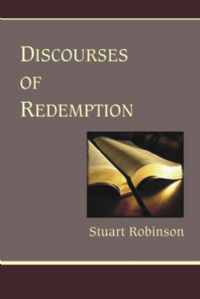




 |
|||||
 |
DISCOURSES OF REDEMPTION: Addresses on the Unfolding of God's Salvation Plan Through the Scriptures
STUART ROBINSON with New Introduction by Dr. C.N. Willborn![]()
WE PURCHASED ALL THE REMAINING COPIES OF THIS WONDERFUL TITLE- NONE REMAIN!!![]()
In 1867, Robinson placed before the American public “specimens” of his biblical expositions, which considered a logical development of the gospel as it unfolded historically. In this brief description of his book one learns that redemption (“the gospel”) was in view as it was progressively unfolded. In short, Robinson was presenting to the public the Scriptures as redemptive history, showing sensitivity to the linear-historical nature of revelation…Robinson explained that the mode of the Bible’s revelation is through a series of covenants, each one a larger development of that which precedes it. Successive covenants mark the expansion of revelation as it flows from the gracious hand of God. This idea, as noted above, guided Robinson ten years earlier when he published his work on ecclesiology. Each period of revelation is marked by a divine covenant—Adamic pre-lapsarian, Adamic post-lapsarian, Noahic, Abrahamic, Mosaic, Davidic, and Messianic (New Covenant). During each of these periods there was a development and accumulation of revelatory data regarding what man was to believe concerning God and what God demanded of man.![]()
These expositions were preached to growing congregations in order to display the organic unity of Holy Scriptures and the center of theology —redemption through the Seed promise. Robinson’s rationalization of these expositions should excite every pastor-teacher: “Having, through a ministry of twenty years, to congregations variously composed, in four different cities, been accustomed, in pursuance of the latter theory of preaching, to appropriate one of the public services of the Sabbath to showing the people how to read the scriptures, and to follow the development of the one great central thought of the Book through the successive eras of revelation—the author can testify from practical experience that the people need no other attraction to draw them to the house of God than a simple, rational and practical exposition and illustration of the Bible. And he who may once attract them by such teaching will find no occasion for devising sermons on special subjects, or any other theatrical devices to draw men to the sanctuary,” (Discourses, iv).![]()
TABLES OF CONTENTS![]()
INTRODUCTORY DISCOURSES![]()
DISCOURSE I - THE DIVERSITY IN UNITY OF THE REVELATION OF REDEMPTION.![]()
Hebrews i. 1, 2, and ii. 1-4![]()
DISCOURSE II - THE SCRIPTURES OF THE “SUNDRY TIMES” INSPIRED OF GOD:![]()
THE ONLY SOURCE OF SAVING KNOWLEDGE: THE ANTIDOTE TO PERILOUS ERROR.![]()
II. Timothy iii. 1, 16.![]()
SECTION I.![]()
DISCOURSE III. - REDEMPTION AS REVEALED TO THE PATRIARCHS IN THE THEOPHANIES. THE GOSPEL COVENANT AND WORSHIP OF THE LOST EDEN.![]()
Genesis ii. 8-17; iii. 15, 24, and iv. 4![]()
DISCOURSE IV. - THE GOSPEL CHURCH VISIBLE SEPARATELY ORGANIZED: ITS COVENANT CHARTER WITH ITS SEAL: ITS CONSTITUENT ELEMENTS.![]()
Genesis xvii. 4, 7, 10, 11, 13.—Romans iv. 11.—Mark x. 14.![]()
SECTION II.![]()
REDEMPTION AS REVEALED IN THE LAWS AND ORDINANCES OF THE THEOCRATIC ERA.![]()
DISCOURSE V. - THE COVENANT OF THE CHURCH’S REDEMPTION; ITS SEAL AND THE SIGNIFICANCE THEREOF.![]()
Exodus xii. 3, 7, 11-14.—Luke xxii. 15, 20.—I Corinthians v. 7, 8.![]()
DISCOURSE VI. - THE GOSPEL OF THE SINAI COVENANT: ITS RULE OF LIFE TO CONVICT OF SIN: ITS RITUAL TO TEACH THE TAKING AWAY OF SIN: AND ITS MOULDING OF THE SOCIAL ORDER AS A TYPE OF CHRIST’S SPIRITUAL COMMONWEALTH.![]()
Exodus xix. 3-6, xx. 1-17, xxiv. 7-9.—Deuteronomy v. 2, 3, 22, vi. 1-5, x. 1-5.![]()
SECTION III.![]()
REDEMPTION AS REVEALED THROUGH THE SPIRIT OF CHRIST IN THE PROPHETS.![]()
DISCOURSE VII. - THE GOSPEL CHURCH BY COVENANT TYPICALLY SET FORTH AS THE ETERNAL KINGDOM OF DAVID’S SON.![]()
II. Samuel vii. 1-24.—Psalm Ixxii. 1, 8, 17.—xxxix 3, 4.—Luke i. 32.—Acts ii. 30.![]()
DISCOURSE VIII. - THE GOSPEL OF THE KINGDOM IN CONFLICT WITH AN APOSTATE CHURCH; AND WITH DESPONDING FAITH.![]()
I Kings xviii. 17-20, and xix. 1-14.![]()
DISCOURSE IX. - THE GOSPEL OF PARDONING MERCY AS PREACHED BY THE PROPHETS OF THE KINGDOM.![]()
Isaiah i. 10-18.![]()
SECTION IV.![]()
REDEMPTION AS TAUGHT BY JESUS THE INCARNATE WORD.![]()
DISCOURSE X. - THE OFFICIAL AUTHORITY, NATURE, LIMITS, AND PURPOSES OF GOSPEL PREACHING.![]()
Luke iv. 16-21.![]()
DISCOURSE XI. - THE GROUND OF OUR SALVATION NOT ETHICAL BUT EVANGELICAL; AND LIES WHOLLY IN THE INFINITE DESIRE OF FATHER, SON AND SPIRIT TO SAVE SINNERS.![]()
Luke xv.![]()
DISCOURSE XII. - THE AWARD OF THE JUDGMENT TO COME TO BE MADE ON PRINCIPLES NOT ETHICAL BUT EVANGELICAL.![]()
Matthew xxv. 31-46.![]()
DISCOURSE XIII. - THE DIVINE TRAGEDY OF EARTH, HEAVEN AND HELL.—HUMANITY IN ITS OWN ESSENTIAL ATTRIBUTES TO INHABIT ETERNITY.![]()
Luke xvi. 19-31![]()
DISCOURSE XIV. - REDEMPTION AS PREACHED AT THE FINAL APOSTASY OF THE TYPICAL KINGDOM, IN THE “LIFTING UP” AND THE “PIERCING” OF JESUS ON THE CROSS.![]()
John xix. 15-37, iii. 14. and xii. 32, 33.![]()
SECTION V.![]()
REDEMPTION AS PREACHED BY APOSTLES UNDER THE DISPENSATION OF THE SPIRIT.![]()
DISCOURSE XV. - THE APOSTOLIC STATEMENT OF THE TERMS OF SALVATION.![]()
Acts. xvi. 29-31.![]()
DISCOURSE XVI. - THE APOSTOLIC SUMMARY OF THE CHRISTIAN CREED.![]()
I Timothy i. 15.![]()
DISCOURSE XVII. - THE APOSTOLIC GROUND OF CHRISTIAN COMFORT AND COURAGE.![]()
Romans viii. 28-31.![]()
DISCOURSE XVIII. - THE GOSPEL DOCTRINE OF IMMORTALITY CONTRASTED WITH THAT OF THE SCHOOLS.![]()
II Timothy i. 10.—I Cor. xv. 22, 53, 54![]()
DISCOURSE XIX. - THE GOSPEL ALARM.—ITS IMPORT.![]()
Ephesians v. 11.![]()
SECTION VI.![]()
REDEMPTION AS PROCLAIMED BY JESUS ASCENDED; CONFIRMING ALL THAT HAD BEEN REVEALED AT THE “SUNDRY TIMES AND IN DIVERS MANNERS.”![]()
DISCOURSE XX. - THE GOSPEL ADAPTED TO THE CONSCIOUS WANTS OF THE HUMAN SOUL; ITS ARGUMENTS, TERMS AND AGENCIES.![]()
Revelations xxii. 16-18.![]()
APPENDIX.![]()
NOTE A. TO DISCOURSE III. - THE RECENT OBJECTION IN THE CHURCH OF SCOTLAND CONCERNING THE PERPETUAL OBLIGATION OF THE SINAI COVENANT, AND ITS SABBATH.![]()
NOTE B. TO DISCOURSE IV. - THE PLACE OF THE CHURCH IN THE SCHEME OF REDEMPTION.![]()
NOTE C. TO DISCOURSE X. - THE ORDINANCES OF PUBLIC WORSHIP AS SET FORTH IN SCRIPTURE; THEIR RELATION TO THE IDEA OF THE CHURCH.![]()
NOTE D. TO DISCOURSE X. - THE RELATION OF THE TEMPORAL AND THE SPIRITUAL POWERS HISTORICALLY CONSIDERED. THE SCOTO-AMERICAN THEORY.![]()
(From the Introduction to the new edition by C N Willborn)![]()
Stuart Robinson was born among the Scots of Strabane, County Tyrone, Ireland, in 1814. As a child he suffered in an accident that left him with a crippled arm. During Stuart’s infancy his father moved the Robinson family to Virginia where the precocious youngster eventually received primary education from the Reverend James M. Brown and the most notable William Henry Foote. His graduate and post-graduate studies took him to Amherst (Massachusetts) College, Union (Virginia) Seminary, and Princeton (NJ) Seminary. From this solid upbringing he went on to become a prominent pastor in Virginia, Maryland, and Kentucky and served for a time as professor with R. J. Breckinridge in the Danville (KY) Theological Seminary. He was a churchman, publisher, author, theologian, and pastor. He died in 1881 after twenty-three years as pastor of Second Presbyterian Church, Louisville, Kentucky. His body rests united to Christ in the beautiful Cave Hill Cemetery in Louisville.![]()
MG70![]()
SORRY, BUT THIS VOLUME IS SOLD OUT![]() SGCB Price: $35.00 (list price $35.00)
SGCB Price: $35.00 (list price $35.00)![]()
